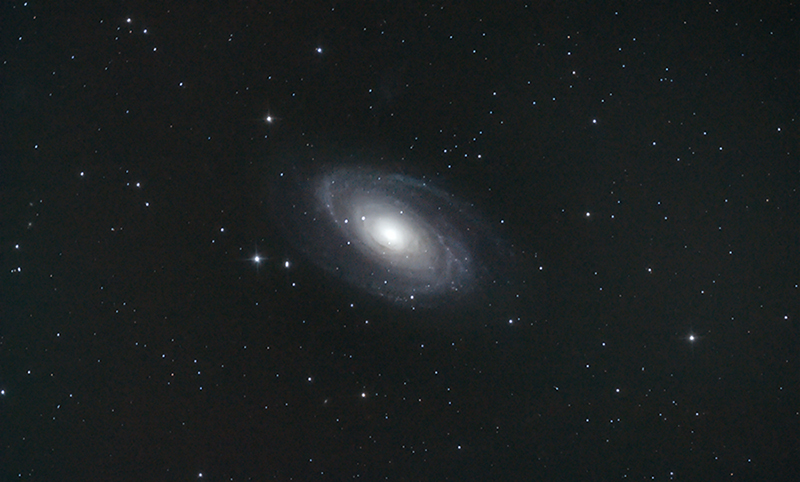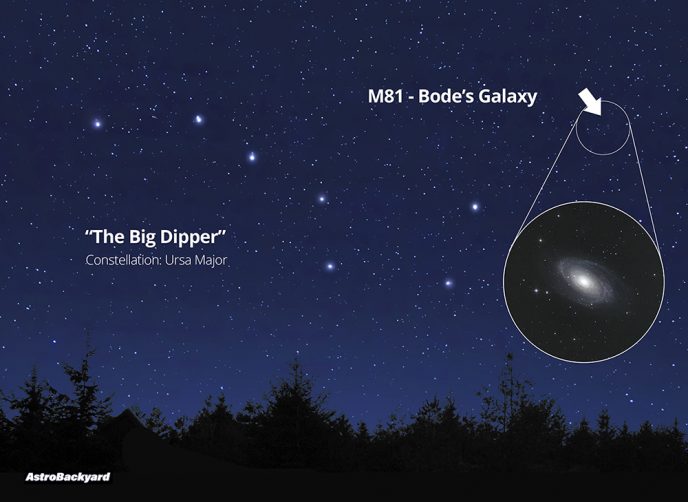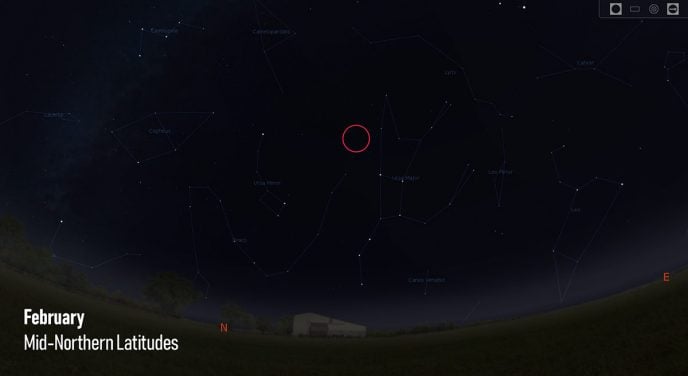M81 – Bode’s Galaxy
Messier 81, also known as Bode’s Galaxy is a grand design spiral galaxy in the constellation Ursa Major. M81 is one of the brightest galaxies in our night sky, as seen here on Earth.
Its size and well-defined spiral arms make it an enjoyable sight through almost any telescope or even a pair of binoculars. A telescope with an aperture of 8″ or more will show more detail under dark skies.
In the video below, you’ll see me photograph Bode’s Galaxy from my backyard using a camera and telescope. This galaxy is a great choice to consider during Galaxy Season.
Bode’s Galaxy lies approximately 11.8 million light-years from Earth, with an apparent magnitude of 6.9. Bode’s Galaxy is located about 10 degrees northwest of Dubhe in the corner of the Big Dipper‘s bowl.
Many other galaxies are also located in the surrounding area. The Cigar Galaxy (M82) lies so close to M81, that they are often photographed together using a wide-field telescope.
Amateur Astrophotography Image using an 8″ Orion Astrograph – Bode’s Galaxy in Ursa Major.
- Cataloged: Messier 81, NGC 3031
- Common Name: Bode’s Galaxy
- Constellation: Constellation
- Distance: 11.7 million light-years
- Size: 90,000 light-years in diameter
- Magnitude: +6.94
- Discovered: 1774
M81 – Star Chart
Where to find M81 – Bode’s Galaxy
In the northern hemisphere, Bode’s Galaxy is not difficult to locate in the night sky. This galaxy is bright enough to observe under light-polluted skies, as I am able to easily spot it during the new moon phase under my Bortle Scale Class 8 backyard sky.
Look towards the Big Dipper in Ursa Major, and use the stars Merak and Dubhe to draw a line towards M81 and M82. From there, point your telescope below and to the right of this line, and you should see the glow of Bode’s Galaxy after scanning the area.
From mid-northern latitudes, the best time to observe and photograph Bode’s Galaxy is between the months of February to May. As you can see in the screenshot (created using Stellarium), Ursa Major reaches high into the sky during these months, meaning that there is less chance of running into a terrestrial obstruction when trying to locate M81.
The location of M81 from mid-northern latitudes. February at 8:00pm.
Photographing Bode’s Galaxy
Deep-sky astrophotography involves attaching a camera to a telescope (or long focal-length camera lens). For my latest photo of Bode’s Galaxy, I used a large Schmidt-Cassegrain telescope (SCT), the Celestron EdgeHD 11.
This telescope has a focal length of roughly 2000mm when the 0.7X reducer is used (2800mm x 0.7X reducer = 1985mm). At this magnification, I was able to photograph M81 up-close and reveal plenty of interesting details in the spiral arms of the galaxy.
When photographing deep-sky objects at this magnification, accurate tracking of your equatorial telescope mount and the use of autoguiding are a must. Polar alignment and telescope pointing accuracy also become critical when taking images at this focal length.
Bode’s Galaxy. 4 Hours Total Exposure (Bortle 7).
The image includes 80 x 3-minutes exposures using a ZWO ASI2400MC Pro color astronomy camera. I did not use a light-pollution filter for this shot, opting to deal with gradients and skyglow during the post-processing stages of the image.
Unlike many of the nebulae and galaxies I shoot, this object sits in a convenient location (near the pan of the Big Dipper) from my latitude, and allows me to capture multiple exposures nearly all night long.
The image circle of the telescope and reducer would not accommodate the full-frame sensor on my camera, meaning I had to crop the final image by about 15% to ignore the vignetting created by the optical train.



